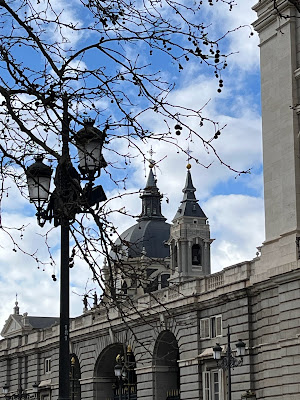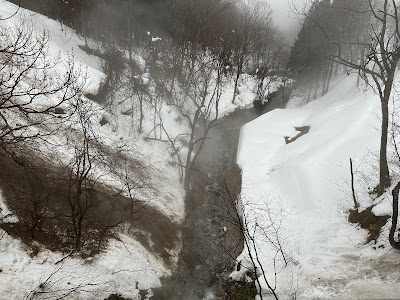 |
| Two-time Super Bowl champions: offensive coordinator Eric Bieniemy and quarterback Patrick Mahomes of the Kansas City Chiefs |
Craig, every second Tuesday.
Kia ora and gidday everyone.
I hope you're all having a good week as we hurtle towards Spring here in the Northern Hemisphere.
Before I dive into today's topic, I want to pause for a moment to send some kind thoughts, aroha and virtual hugs to my compatriots back home in Aotearoa New Zealand who've been dealing with some very unseasonable weather including destructive flooding and Cyclone Gabrielle as summer wanes. Thanks to everyone helping those in need in the aftermath of what's been called a 'once in a century' weather disaster. (Though there are fears these kinds of things will become more common all over the world given climate change.) It's surreal to think I was there on the ground in New Zealand last month, but am now watching from half a world away. Kia ora to all the helpers.
 |
| Flooding in Wairoa on Valentine's Day (cr: Wairoa Civil Defence) |
Another thing that happened earlier this month was the Super Bowl, one of the world's biggest sporting events. The Kansas City Chiefs, who you'd probably have to say have been the best team overall over the past five years (five straight AFC Championship appearances, three Super Bowl appearances, two wins), won their second Super Bowl of the Patrick Mahomes era, in a comeback victory over the Philadelphia Eagles, who had a tremendous season too.
One historical note: it was actually the first time two black quarterbacks had faced off against each other in the Super Bowl, with Patrick Mahomes for the Chiefs vs Jalen Hurts for the Eagles. While this may not seem like a big deal in a sport where at any time 60-70% of the players are black, and given all the other storylines this year it wasn't talked about as much as it might have been otherwise, despite it being Black History Month, it was historic.
For while this was Super Bowl 57, meaning there have been 114 opportunities in history for quarterbacks to start in the Super Bowl, Hurts became only the eighth black quarterback to start in a Super Bowl (11 total Super Bowl starts by black quarterbacks, with Russell Wilson making two appearances and Patrick Mahomes three, so far).
 |
| Doug Williams was not only the first black quarterback to play in or win a Super Bowl (and the only one for the first 30+ years of the modern NFL), but the first black QB to ever be drafted in the first round, the 17th overall pick by Tampa Bay |
And while Doug Williams quarterbacked the then-Washington Redskins to victory in Super Bowl XXII back in 1988, for a long while he was a solitary figure, until Russell Wilson won in 2014 (Steve McNair and Donovan McNabb started in Super Bowls and lost in the 2000s). So most of the history of black quarterbacks in Super Bowls, and in the NFL more generally, has been fairly recent, with five of those eight QBs - Colin Kaepernick, Russell Wilson, Cam Wilson, Mahomes, and Hurts - making a total of eight Super Bowl starts just in the past decade, 2013-2023.
Also, after McNair was the sole black quarterback to win NFL MVP in the first 49 years of the Super Bowl era, four of the last eight NFL MVPs have been black quarterbacks (Cam Newton, Lamar Jackson, Patrick Mahomes twice)
So things are changing, increasingly rapidly, which is great to see but there's a long, many-decades history of black football players being told they were amazing athletes but not really suited to be NFL quarterbacks. Some were told they needed to change positions to succeed at the highest level. Even those that were successful at college or in the pros were often praised for their athleticism while lesser white quarterbacks were described as more cerebral or having more leadership skills or 'being able to understand the offensive schemes well'. Lots of coding there.
 |
| Dak Prescott of the Dallas Cowboys and Jalen Hurts of the Eagles are among a new generation of black quarterbacks leading their franchises in the NFL |
So why am I talking about this, when it seems that things have improved a lot, with many NFL teams now having black quarterbacks on their rosters, starting, getting big contracts, and leading them to the playoffs and beyond?
Well, for two reasons. Three, I guess, if you include that it's Black History Month so some of these issues are on my mind, eg how black people (as well as other people of colour or underrepresented or historically oppressed groups) are often in many fields historically and still given far less opportunities, are less likely to have 'risks' taken on them by decisionmakers and those in power compared to other people, or get less second/third/fourth etc chances if they stumble or initially fail.
First, Eric Bieinemy.
 |
| Running back turned coach Eric Bieniemy pictured with one of the two Super Bowl trophies he helped the Kansas City Chiefs win as Offensive Coordinator |
While the long-held fallacy that 'black players just aren't as suited to be NFL quarterbacks' seems to have withered, it hasn't completely died - it seems it's just been transferred to black coaches, particularly offensive coaches. Sadly, many of the same archaic notions seem in place - 'sure, black guys can play football at an elite level, but can they coach'? Or maybe they can be defensive coaches or running backs coaches, 'but can they be the offensive wizards with amazing schemes the modern NFL needs?' Even if they're successful OCs, can they lead an entire team?
It's the old athlete vs thinker/leader thing again, in a different guise.
Eric Bieniemy, who has been offensive coordinator during the entirety of the Kansas City Chiefs most successful era ever (Two Super Bowl wins, three appearances, and five straight home AFC Championship games in a five-year period), seems like one of the most qualified, best head coaching candidates in football - and has been for years - and yet still hasn't gotten a head coaching job, despite numerous interviews. None of the NFL owners who've been looking for new coaches, sometimes repeatedly, in recent years have been willing to 'take a risk' on him to lead their team, despite all his achievements. The goal posts of what gets someone a head coaching opportunity seem to be continually shifting, and it seems again and again black head coaches like Bieniemy are the ones missing out.
 |
| Jim Caldwell inherited a moribund Detroit Lions team and went 36-28 in four seasons, the best record of any Lions coach in the Super Bowl era, yet was fired. His replacements went 17-46-2 over the next four seasons. |
This week Bieniemy took a job as OC/Assistant Coach with Doug Williams' old franchise, the re-skinned Washington Commanders, seemingly as a way to prove he could completely run an offense rather than doing so under the guidance of 'offensive guru' Andy Reid, the Kansas City head coach who seems to get the bulk of the coaching credit for Kansas City's success from media and fans, even though he and Mahomes praise Bieniemy.
So Bieniemy has had to go from about the best OC job you could have (coaching Patrick Mahomes) to a mess of a franchise, under Daniel Snyder, in order to prove the doubters wrong. While many other coaches haven't been held to remotely the same standards before getting head coaching opportunities, often repeatedly. And Bieniemy is only one of many black coaches that seem to be getting similar treatment nowadays to the black quarterbacks of the past - 'not quite suited for the top role', rarely given opportunities, quickly discarded, and fewer second/third chances.
For those who say Bieniemy doesn't completely run the Kansas City offense because of Reid's involvement, Reid's past offensive coordinators Brad Childress, Matt Nagy, and Doug Pederson were all hired to be head coaches - learning under Reid was seen in their case to be a benefit, an asset, not something that held them back. And none of them had close to the success as offensive coordinators for the Eagles or Chiefs under Reid that Bieniemy has had. They were all white though.
Reid has even had his special teams coordinators, like John Harbaugh, hired to head coaching jobs.
 |
| Eagles offensive coordinator Shane Steichen was hired as Indianapolis Colts head coach after making it to this year's Super Bowl, losing to Eric Bieniemy's Chiefs. |
Most recently, just before he took the Washington OC/Assistant Coach job, Bieniemy had apparently been interviewed for the vacant Indianapolis Colts head coaching position. Frank Reich had been fired mid-season, replaced by former Colts player and TV analyst Jeff Saturday. Immediately after this year's Super Bowl, the job went to Shane Steichen, a three-year OC who'd worked with Justin Herbert in LA and Jalen Hurts in Philadelphia, putting up good offensive numbers, schemes and performances in each case - but not better than Bieniemy's over those same three years. Steichen seems touted as a 'young guru' for his work elevating Jalen Hurts.
And for those who say it's just bad luck, Bieniemy was beaten out by better/more suitable candidates each time, fewer than half of the head coaches hired for the 16 or so head coaching jobs Bieniemy has interviewed for and not been given in recent years have subsequently made the playoffs, and several have already been fired. But the owners who hired them felt they had something Bieniemy didn't. Maybe not success, maybe not resume, but something else.
Why does this matter, some may ask?
Because Bieniemy's situation is a symptom of a much bigger issue, not just in the NFL coaching carousel, but beyond. Where certain people are given opportunities and risks are taken on their behalf, and others are not. Regardless of resume. Even where people are given chances, some are given many more opportunities to fail, learn, and grow, whereas others are quickly discarded. And in the books world we've seen similar trends historically, though thankfully like the black quarterback situation in the NFL, it's improving.
 |
| Crime Writers of Color co-founders Kellye Garrett, Walter Mosley, and Gigi Pandian at Malice Domestic in 2022 (cr: CWoC) |
Which was one of the reasons I was so stoked to see the news earlier this year that not only was one of my favourite crime writers, Michael Connelly, going to receive the MWA Grand Master accolade at this year's Edgar Awards, but that the fabulous Crime Writers of Color (CWoC) organisation, founded in June 2018, was to receive the prestigious Raven Award for "outstanding achievement in the mystery field outside the realm of creative writing".
Speaking for CWoC, cofounders Gigi Pandian, Kellye Garrett, and Walter Mosley wrote:
“When we first started talking about the idea that became Crime Writers of Color, we never imagined the small informal group would become such a big and thriving community in just a few years. Our goal was always to create a safe and supportive space for fellow writers of color to network and thrive. So, to know that the group is making a positive impact in the mystery community as a whole is so gratifying, and to be recognized by MWA in our fifth year is such an honor! We thank you on behalf of all our 350-plus members who are in all stages of their career.”
As a reviewer, awards judge, features writer, event chair, and just long-time lover of great crime, mystery, and thriller storytelling, it's been absolutely fabulous to see the rise and rise of more and more diverse voices in our genre in recent years. For a long time our genre was a little too like the NFL quarterback situation, with writers such as Chester Himes or Walter Mosley or Barbara Neely being like Doug Williams, the rare exceptions.
 |
| It was great to see a new Penguin Classics reissue in 2021 of five Chester Himes' hardboiled Harlem Detective novels from the 1950s-1960s |
It's terrific that those pioneers have now been followed by hundreds of BIPOC crime writers penning tales all across the various sub-genres of crime, mystery, and thriller writing, from rural noir to cosy mysteries to psychological thrillers to horror-crime to legal thrillers and more. I had intended to do a wee 'Ten Black Authors to Try' listicle given it was Black History Month, but the sports part of my 'sports loving book nerd' Twitter bio took over more here today, and this post has already gotten far longer than I'd originally intended. So I'll just say check out the Crime Writers of Color website for lots of fabulous authors, and when you're browsing online or instore or at your local library, keep an eye out for some of the fabulous diverse voices that are refreshing and elevating our genre.
For me personally, many of my favourite reads of recent years have been from black authors like Attica Locke, Kellye Garrett, SA Cosby, Walter Mosley, John Vercher, Oyinkan Braithwaite, Femi Kayode, and Stephen Mack Jones, along with other crime writers of color like Steph Cha, JP Pomare, Naomi Hirahara, Michael Bennett, Vaseem Khan, Renee, Tariq Ashkanani, and David Heska Wanbli Weiden, among others.
You really can't go wrong. We're blessed with so much talent in crime, mystery, and thriller writing. Dive in.
Until next time. Ka kite anō.
Whakataukī of the fortnight:
Inspired by Zoe and her 'word of the week', I'll be ending my fortnightly posts by sharing a whakataukī (Māori proverb), a pithy and poetic thought to mull on as we go through life.
He kai kei aku ringa
(There is food at the end of my hands, ie a person can use their abilities and resources to create success.)



























.jpeg)














.jpg)


























